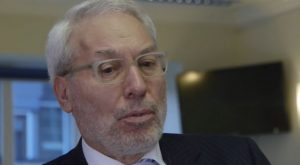 By Prof. Fritz Vahrenholt at Die kalte Sonne
By Prof. Fritz Vahrenholt at Die kalte Sonne
(Translated by P. Gosselin)
June 7, 2020
Dear ladies and gentlemen
First, the global mean temperature of satellite based measurements was surprisingly much higher in May 2020 than in April. In contrast, the global temperatures of the series of measurements on land and sea decreased. The difference can be explained by the fact that under warm El-Nino conditions the satellite measurements lag about 2-3 months behind the earth-based measurements.
From November 2019 to March 2020 a moderate El-Nino was observed, which has now been replaced by neutral conditions in the Pacific. Therefore, it is to be expected that also the satellite based measurements, which we use at this point, will show a decrease in temperatures within 2-3 months.
The average temperature increase since 1981 remained unchanged at 0.14 degrees Celsius per decade. The sunspot number of 0.2 corresponded to the expectations of the solar minimum.
The earth is greening
In August 2019, I reported on a remarkable publication by the Max Planck Institute for Meteorology in Hamburg: “Our main finding,” said Aexander Winkler’s researchers at the time, “is that the effect of CO2 concentration on terrestrial photosynthesis is greater than previously thought and therefore has important implications for the future carbon cycle.
According to this, the CO2 attenuation effect of plants is 60% higher than the average of climate models had assumed.
“In the last two decades, an average of 310,000 km² of additional leaf and needle area – roughly the size of Poland or Germany – has been created every year,” the researchers say. I had shared this important finding with the members of the German Bundestag at the time, which led Stefan Rahmstorf to conclude that I was “trying to fool the German Bundestag“. This assessment was taken up by some media such as the TAZ and ultimately led to my dismissal as sole director of the German Wildlife Foundation.
New confirmation: CO2 uptake by plants is increasing
In April ,2020, a research group led by the Australian scientist Vanessa Haverd published a paper in Global Change Biology which more than confirmed the findings of the Max Planck Institute. The researchers describe that plants have absorbed 30% more CO2 since 1900. The previous estimates were 17%. In their calculation for a mild increase in CO2 in this century (IPCC scenario 2.6), the researchers led by Vanessa Haverd arrived at a net uptake of 528 billion tonnes of CO2 by plants by 2100, compared to the 238 billion tonnes of CO2 previously calculated by climate models.
According to Adam Riese, this is more than twice as much. By way of comparison: In scenario 2.6, a total of 1000 billion tonnes of CO2 (IPCC, Chapter 6, p. 468) will be emitted in this century. Today the plant world absorbs about 30% of the anthropogenic CO2 annually, the oceans another 24%.
In contrast, the statement of the IPCC in its last report from 2013 (p.26 of the Summary for Policymakers) is diametrically different: “Based on Earth system models, there is a high confidence that the feedback between climate development and the carbon cycle in the 21st century is positive. As a result, more of the anthropogenic CO2 emitted will remain in the atmosphere. Maybe I need to write to the German Bundestag again.





But still models. Models only ever of use when they are an airfix spitfire for the grandson to play with.
Oh Oh! Oh! I want one! I want one! I want one!
Seriously, that’s one beautiful airplane.
https://imodeler.com/2015/08/airfix-148-scale-spitfire-mk-22/
For the grandson. Sure.
OT, but how about a DCS (google it) Spitfire for you both to play with?
Dr. Ed Berry has his carbon cycle model paper nearly ready for submittal
https://edberry.com/blog/climate/climate-physics/preprint3/
He shows several errors in the IPCC core theory and calculates that humans have only increased the CO2 in the atmosphere by 33 PPM (15% of the increase) agreeing with Harde and Salby.
Add some natural gas, some nitrogen, 200 bar, voila, anhydrous ammonia, the Haber-Bosch process has increased food production worldwide for probably a good 100 years.
You have anthropogenic produced carbon dioxide and carbon monoxide in the process. Since you’ll have more success at food production, it is a wash.
You don’t create a thing, it is all there waiting to be chemically transformed.
It works, the stoichiometry says it can happen and probably will happen without a chemist doing it industrially, nature takes its course too.
I guess it could all happen naturally with mankind benefiting from what nature offers, stop fiddling with it all.
Eliminate hydrocarbons, don’t use them, make it all go back to where it was before coal and oil came along.
See what happens.
It won’t take long, no cars moving, no trucks moving, no trains moving, no planes moving, no ships moving, no power plants, no nuclear, no water systems, no electricity, see what you’ll get from it all.
What do you think you will get as a result?
You’ll have a misery index in the red with the needle pegged.
Hydrocarbons obtained from fossil fuels power civilization and civilization will collapse in a New York minute without them.
Just another manifestation of the IPCC’s complete failure to understand atmospheric CO2 – the pedestal of its alarmism.
Perhaps Dr Vahrenholt should read the paper of Dr Harde.
Oh what a surprise — NOT!
My next prediction …
Next up researchers will be surprised to find that plants and soil biota actually absorb more of that infrared radiation during the day (using it to initiate, then maintain the CO2 take-up) than previously expected.